|
|
Post by Runewalker on Aug 26, 2007 11:33:43 GMT -5
I am confused about all the various permutations of Squires. I find these cheap all the time, of course, because they are .... cheap. However, budding Yngwies often put in better pups then sell the things for less than the cost of the pups, so I harvest them. Just bought a Bullet for $70 bucks with authentic Gibson P90s, go figure since these routinely go for $50-80 each on eBay. After stripping the parts I want, I usually patch the thangs up and sell them back to the public cheap, doing my part to reduce global warming by recycling Chinese products, just don't chew the paint off the strat horns. Al Gore is proud, although looks like he might have been nibbling something with way to much enthusiam. Alright, so what't the question? Is there a definitive link that spells out the differences between all the Squire models? so far I have seen Squier: - Affinity
- Standard
- Squier Custom
- Vintage
- Delux
- Ultimate
- Bullet
What is the differnce between all of these, especially in terms of bodies and necks? |
|
|
|
Post by sumgai on Aug 26, 2007 13:33:50 GMT -5
RW, Well, when you wake up in the morning, you pose hard questions, don't you?  You might start here for some of the answers: en.wikipedia.org/wiki/SquierBelieve it or don't, there's some in-depth information there that I haven't seen elsewhere. At the bottom, there's a link to the official Squier website, but on that site, there's no timeline or history, so I didn't include it here. And FWIW, awhile ago on this forum, we all agreed that the Affinity is to the Squier as the Squier is to the regular Fender. IOW, it's a Squier's Squier, or Squier 2.    HTH sumgai |
|
|
|
Post by ChrisK on Aug 26, 2007 23:33:13 GMT -5
Er, you mean an Affinity is a regular Squier/2.
So likewise, a Mexican (regular) Fender must be a U.S. (?irregular?) Fender/2.
And, a regular Squier = a Mexican (regular) Fender/2.
Ergo, an Affinity = a U.S. Fender/8.
This argument holds when you consider that an Affinity is aboot 1/8th the cost of a U.S. Fender.....
|
|
|
|
Post by jmartyg on Aug 27, 2007 21:36:15 GMT -5
Chris, there is a flaw in your math..
I have a Mexican Squier..
|
|
|
|
Post by ChrisK on Aug 29, 2007 18:08:29 GMT -5
Well, If'n you'd posted that in the first place......  So, you want to introduce an upscale downscale.......(otherwise known as a Deluxe Squier in some cases).  I'll leave the new equation to you. It should be easy since they're aboot twice the cost of an Affinity.  |
|
|
|
Post by Runewalker on Aug 31, 2007 8:29:59 GMT -5
Well I've seen the assertion made twice now equating price to worth or value. It bothered me the first time, but I had a little lecture with myself to let it go. Then boom, there it is again. Intrinsic worth or quality is only partially reflected in market price, and may be perverted by brand demand effects on the pricing. Often times the brand premium supersedes the quality value. The math was fun, but the presumption of: "This argument holds when you consider that an Affinity is about 1/8th the cost of a U.S. Fender....." or
"I'll leave the new equation to you. It should be easy since they're about twice the cost of an Affinity" is fundamentally askance because of the price premium attached to branding. When Fender first released the Squire to the market the business strategy was a pure brand name extension. Not much different than Proctor and Gamble putting out a "new and improved" or "now in family size" soap boxes. Fender (the company, not the man) knew that garnishing the starter market brought in margin on these units because they were cheap to produce (which was the core basis of Leo's manufacturing model in the first place --- bolt-on, pup-packed pick-guarded (say that fast 10 times) guitars were cheap to produce, especially compared to a certain set-neck, back-routed competitor). Going to the downscale market had the added benefit of inculcating brand loyalty at an early age, and capturing the "move up" market to the more expensive, but marginally better up-branded Fender units. They have a traditional trifurcated product line, cheap, cheaper, cheapest. Squire, Mexican, and MIA (and older MIJ). As to price equaling quality -- quality is an inherent attribute based on materials, engineering and manufacturing precision - not price. While price and quality are often associated, they are not always indicative in final sales price. Where quality production demands cost-of-goods (manufacturing components) that have more expensive labor costs measured in time (not location - IE, China vs Mexico, Mexico vs US), more expensive materials, more expensive precision components, recovering these costs in retail pricing requires higher prices or the enterprise cannot cover its costs, and crashes. But the ineffable wild card in pricing vs quality is the premium conveyed by branding. Imagine buyer who has a keen understanding of, and experience with assessing of quality on its own terms, devoid of branding-driven market-pricing aberances. This buyer visits a purveyor and reviews a number of guitars from different manufacturers. All the guitars for review are pre-selected for component types: Alder bodies, rosewood fret-boards, maple-stock necks, 3 single coils, etc. All the headstocks and stamped metal have evidence of branding covered with tape. This guitar-o-file then moves through the stack and picks ten of the best based on his knowledge and keenly enlivened quality senses. Depending on the criteria, Fender MIAs may not bubble to the top of the heap as the highest quality instruments, nor Squires to the bottom. I see on eBay a funny dichotomy of quality vs price. There are numerous manufacturers who produce Alder bods, with opaque paint, nitro if desired. A generic Strat bod. If the manufacture is unknown the price is approachable. If the bod is branded Warmoth, boom, an automatic $100 or more is attached to the price and manifest in the final buyers bid price. I just saw a bathtub routed bod go for nearly $500 because of the Warmoth brand, whereas the majority of the market there usually devalues swimming pool routed guitars as cheap-to-manufacture, poor quality bods. I have built up and dialed in guitars with $200 of parts that open up a Texas can of Whup-@ss on $1700 MIA Strats, leaving them bawling like a little girl sitting on the curb after falling off of her bike ---- and --- I would be lucky to extract the cost of parts if I sold them on eBay --- purely from buyers marching like lemmings to the back beat of Brand driven valuations. You see it here. Take one of the excruciatingly engineered harness designs of this group that vastly expands guitarist options, and render it precisely by hand. Jerk a jerkwater MIA Fender harness out then post them both on eBay. Which one has the greatest intrinsic value? Which one will bring the highest price. Long-winded? Yes. My apologies. For your equation to accurately depict the relationship between intrinsic value and cost, the brand premium should be determined then subtracted. Why oh why do our threads quickly move to coffee shop level exchanges. I admit, I am culpable, participating in the highjacking of my own thread. SG thanks for the Wiki ref. It is a start, but I was looking for more info on differences in pups, materials, dimensions, components, etc.
The argument that Affinities are cr@p does not hit the ground consistently. I have worked on Affinities that were alder bodied, pups individually routed with components equivalent to the MIM strats. My first strat mod was on one of these and it is a delight, but that is with a premium harness, multiple switching options and better pups. |
|
|
|
Post by ChrisK on Aug 31, 2007 13:16:22 GMT -5
The math WAS fun, but it only "was" since I saw an orderly relationship in pricing structure. There almost is a binary order of magnitude structure afoot here.
And, askance it is.
While I, others, and Fender for sure would like to believe/have you believe that they went after this market with full forward-looking marketing intent, in reality they were having their lunch stolen by the cheap, knock-off off-shore makers back in those days.
We've all heard of the knock-off lawsuits that stopped this, but in reality, there was only one successfully prosecuted with the primary stop-gap measure being the threat of such lawsuits. Fender could not compete with them, and rather than fight, they joined them. This also enable Fender to have a foreign market presence where the U.S. made stuff was way too expensive.
This included England where an embargo on American products from the early 60's onward prevented the importation of U.S. goods (and more than anything else, knighthood not withstanding, enabled Jim Marshall to succeed, initially at just duplicating with European components, the "unattainable" '59 Bassman).
The price/quality metric is only a general guideline. As always, there is wide variance within each model range.
The price of an upper-scale model generally follows the inverse of the logarithmic salary function. If one does twice the work, or delivers twice the value of another, they generally earn aboot 30% more (in a free-economy environment, not one with prescribed labor rates). If one does thrice the work, or delivers thrice the value of another, they generally earn aboot 50% more.
As you go up the feature/quality scale, you go down the volume scale. As a result, born out in the Fender model, each rung incurs aboot a doubling or so in price. One may rightfully assume that the delivered quality is only increasing at a logarithmic rate. Twice the price may well only equate to aboot 30% more in "quality et. al.".
This all presumes a base 10 approach, but a wild a$$ guess is just that.
Generally, the more that one pays for anything infers more quality (which infers many things). I said generally.
While there are many MIA guitar instances that aren't "interesting" due to tone and etc., there is a likely-hood that they will be better, generally, than the less expensive models, and will have more time spent on setup and finish (et. al.).
I often look at Affinity-level models as a starting point for various schemes. For instance, there is a Deluxe Squier SSS that had a basswood satin finish body. I got it for $170 total. I can't buy a finished aftermarket body for that amount. And, I was able to try out six instances.
I have several instances of Squier-level guitars from various sources and I like them a lot. I have several instances of much higher lever guitars and I like them even more.
The low level guitars are not bad guitars. When an especially exemplary example is found, a true bargain hunter's high ensues.
But, when one is building a guitar, and wants the best result, one should buy the best that one can afford, since, generally speaking, the best results are likely(er) to happen.
If one wants to put upscale stuff in a guitar, start high. Even tho you may add $200+ in pickups to a Squier, it's still (and only) a Squier.
Name brand means a lot to a lot of people. I had a guy in a GC sale "want" to buy the Parker P-38 (piezos and magnetics) for $300 clearance, but was completely unable to not buy a Fender MIM Strat for the same $300 since people would believe him more if he played a name brand guitar (hmm, a "look-only" guitar). I saw him four years later and he said "I should have listened to you, but I just couldn't bring myself to."
Name brands carry a premium because that premium can be recovered in a subsequent sale. And because the unaware are unwilling to take "risk" themselves.
"No one ever got fired for specifying IBM." If the thing doesn't work out it's IBM's fault. If I take a risk on an unknown and it doesn't work out, it's MY FAULT.
And then there's that whole "vintage" market....
I agree absolutely.
After all, the journey (that we're all on) IS THE POINT.
|
|
|
|
Post by sumgai on Aug 31, 2007 15:02:08 GMT -5
Chris and RW, While your posts may look like rants, they are more than just level-headed monologues, they serve as "ground rods", bringing sanity to the table in the all-consuming quest for good information, good resources, and most importantly, bang for one's buck. My thanks, and a big +1, to each of you.  Rune, sorry, but the WIKI was all that looked even nearly like your question. I just thought it'd be a start, nothing more. If there is any more detailed info on this, somewhere on the web, I'd also be interested in seeing. But for this topic, my google-fu is weak.  And why oh why can't the cheapie builders ever get it right, and pump out Jazzmasters on the cheap?   You're correct, Warmoth is too full of itself, price-wise.  sumgai |
|
|
|
Post by Runewalker on Aug 31, 2007 15:25:42 GMT -5
CK: We concur. so I guess that means: Concurrence is. While I, others, and Fender for sure would like to believe/have you believe that they went after this market with full forward-looking marketing intent, in reality they were having their lunch stolen by the cheap, knock-off off-shore makers back in those days. Like much of American industry who had to re-learn the painful microeconomics lesson they themselves taught to European manufacturers at the turn of the last century, high margins attract more competitors, who build more efficiently in terms of cost, and drive prices down. Traditional supply/demand dynamics. Fender and GM both were caught with their bellys hanging out so far over their belts that they had to just believe they still had feet, and the Asians busted their chops. So I was giving the "revisionist historian's" version, "oh, yeah, brand extension.... that's what we did..."
This all presumes a base 10 approach, but a wild a$$ guess is just that.
What, no base 17? You could get to base 20 if you used your fingers and toes. Name brand means a lot to a lot of people. I had a guy in a GC sale "want" to buy the Parker P-38 (piezos and magnetics) for $300 clearance, but was completely unable to not buy a Fender MIM Strat for the same $300 since people would believe him more if he played a name brand guitar (hmm, a "look-only" guitar). I saw him four years later and he said "I should have listened to you, but I just couldn't bring myself to." A beautiful story .... and you tell it so well. My daughter prefers $125 'branded' jeans. Arrrrggghhh, they're jeans. Aside. I really admire the innovative approaches Parker has taken with his instruments ... but .... It's just me, but that upper wood-plane-handle cut-away thing he has looks butt ugly. Like these guys making $$ on selling virtual properties in Second Life, substance in commerce is driven, at least partially, on the intangibles. All of that said, now that I have finished my exploratory phase (I think) of seeking the optimal switching arrays, I now find myself craving the aesthetics (intangibles) of swirled and flamed woods, exquisitely rendered. Can't justify in terms of tone, fit or playability, but the Sirens sing. I have a couple of guitars that either have those qualities or the vintage market has gone nutty over that I am frequently afraid to play. So it has been nice to have a harem of cheap dates to thrash around. The tension between abandon and constraint ..... Rock and roll has little business concerning itself over that. |
|
|
|
Post by sumgai on Aug 31, 2007 15:36:18 GMT -5
RW,
Rock 'n Roll has no business concerning itself over abandon versus constraint!
That's what sex and drugs are for!
Hope That Helped!
sumgai
|
|
|
|
Post by ChrisK on Aug 31, 2007 16:32:36 GMT -5
Dangle, dangle... The initial (well, second) HolyKoaCaster body (now replaced). 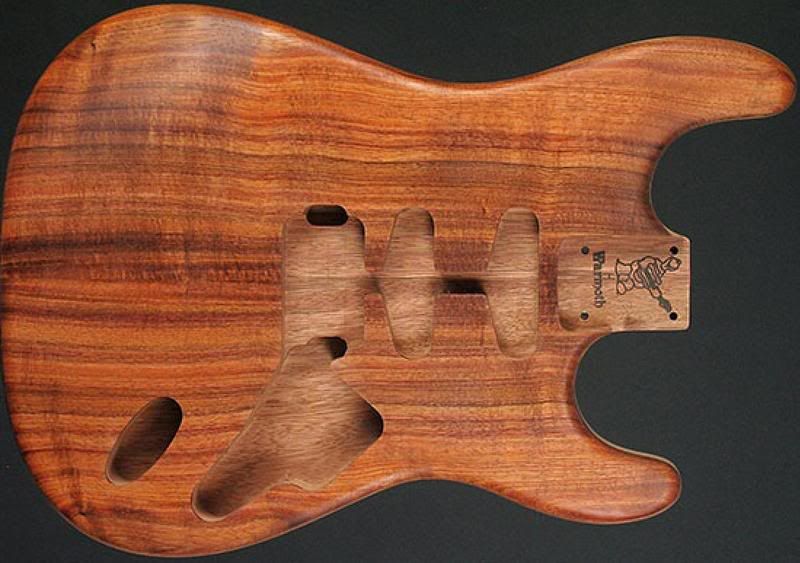 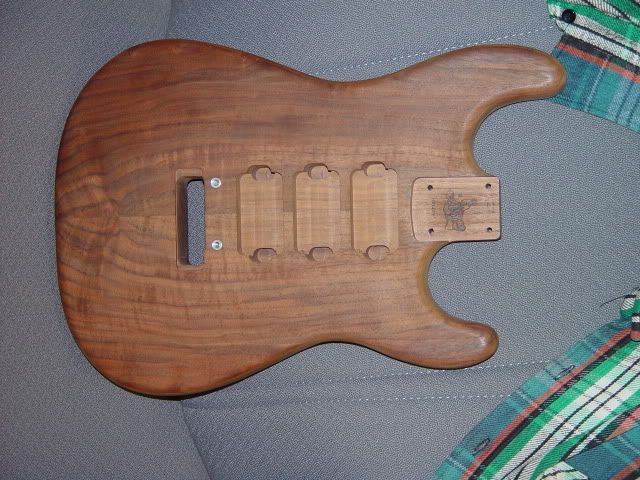 |
|
|
|
Post by Runewalker on Aug 31, 2007 19:32:15 GMT -5
Well I never look at CK's posts as rants, he always has an underlying sense of humor with a bit of paradoxical "let's argue this seriously ... but not..." Whereas, I probably like to prod a bit, challenging presumptions. Which is where, frequently and hopefully, innovation may be found. So see, it is not a rant, but a service to the GN2 community. Yeah, that's it. SG you are so right about the Jags. I badly want one with a 3 P90 rout, and not so much meat taken out of the control cavity. They just don't exist, so eventually I will have to let blood, and join the Warmoth coven to get what I want, or in the antithesis of R&R downsize my desires. and that is just wrong.CK, indubitably those are phenomenal pieces. And I do find myself drooling over the Warmoth store stock. Juicy Lucy. On the unfinished ones, will you do the finish yourself? Chris do you know if Warmoth will go back into one of their Showcase pieces and re-rout additional wood? For example: www.warmoth.com/showcase/sc_guitar_bodies.cfm?type=guitar&start=1&itemNumber=JMP33&menuItem=6&subMenuItem=0&subMenuItem2=0this one could be adapted to 3 P90s, but less than perfectly, of course. On the ash single bridge pup Strat, I see you recessed the path and bushing holes for a Tuno --- to accommodate the increased height. Why not, since Warmoth prides itself on its custom capabilities, just rout the neck cavity for more more meat and more neck heel reveal --- so as to keep the girl's top more virginal? I did have a little of a disappointing experience with Warmoth on a custom pickgaurd. I just wanted a standard outline Strat guard, but wanted the pot holes in non standard positions. Nope, template driven, no exceptions. OK, so much for customization. Has anyone noticed it is easier to dream about and buy parts than it is to finish the d@mn guitars? |
|
|
|
Post by sumgai on Aug 31, 2007 20:29:33 GMT -5
............
Has anyone noticed it is easier to dream about and buy parts than it is to finish the d@mn guitars? Welcome to Parkinson's Law, revisited. It goes something like this: The number of guitar modding projects will expand to fill the time available for starting them, thus reducing by an equal amount the time available for finishing them. Hope that made your day! ;D sumgai |
|
|
|
Post by ChrisK on Aug 31, 2007 22:37:42 GMT -5
?Like this?   I lack the interest in doing anything beyond a tung oil or French polish finish. I will spray necks with satin, but beyond that I buy woods that do not require a finish. Yes, and no. They will do the following re-routs: An "any vibrato" body to a specific vibrato. These are the ones without a top side surface opening. Usually any unrouted pickup location to a specific pickup rout. They will also overlay rout some single coil routs with a humbucker. Ask them specifically. They specifically will NOT do the following: A heel contour on an unfinished showcase body. A vibrato rout on a hardtail routed body. Ask! 253-845-0403 I did not. This rout is the entire point of the "New Recessed Tune-o-matic Rout!" ....and, it isn't ash, it's walnut! ....and it'll have a HSS rout when it arrives. I needed the greater interior control room for the HSS RotoCaster all possible mode wiring that I posted last month. |
|
|
|
Post by Runewalker on Sept 1, 2007 0:01:04 GMT -5
?Like this?  Yes, except for the vast cavity in the lower bout. I prefer retaining as much wood as feasible. And all that stuff about chambering and light weight bodies is for girls. I grew up on Les Pauls that put dents in you shoulder from the straps.... and we liked it! I am also not so sure about that upper bout rout. I would need to think about final pup choices, harness type and switch placements. Ok, Ok, Exclamation mareks .... underlined and bolded. Gee, don't get your panties in a wad there. Still it makes more sense to me to raise the floor of the neck pocket. That has the added benefit of increasing, albeit marginally, the stiffness of that pivot point (neck joint). Thats some awfully light colored walnut there, bub. You didn't use the infrared film did you? It'll darken right up with the walnut stain though, so don't worry. Ok that was uncalled for. I will grant you that you have some exquistly compositioned wood bodies. Not just the grain but the care in book matching is impressive. |
|
|
|
Post by sumgai on Sept 1, 2007 3:30:07 GMT -5
Chris,
The items I always manage to find in the Showcase are either fully Jazzmaster-compliant, or they are already routed for back-loading. I'm looking for a plain-Jane body, preferably with no routing at all, except for the neck pocket, and possibly the bridge...... that'll have to be setup for a Skyway.
And no finish either. I can handle all further routing and finishing, which might be a good clue as to why I'm not enamored with Warmoth's pricing (nor USACG's either).
But thanks for letting us know what's currently available, it's always fun to drool! ;D
sumgai
|
|
|
|
Post by ChrisK on Sept 1, 2007 20:48:35 GMT -5
You can order a body that way methinks. They're just "down the fjord" from you, drop a dime and ask 'em ("sounds" like a plan).  I'm not familiar therewith. Nope, just my infrared eyes. I hope so, it may look like these: 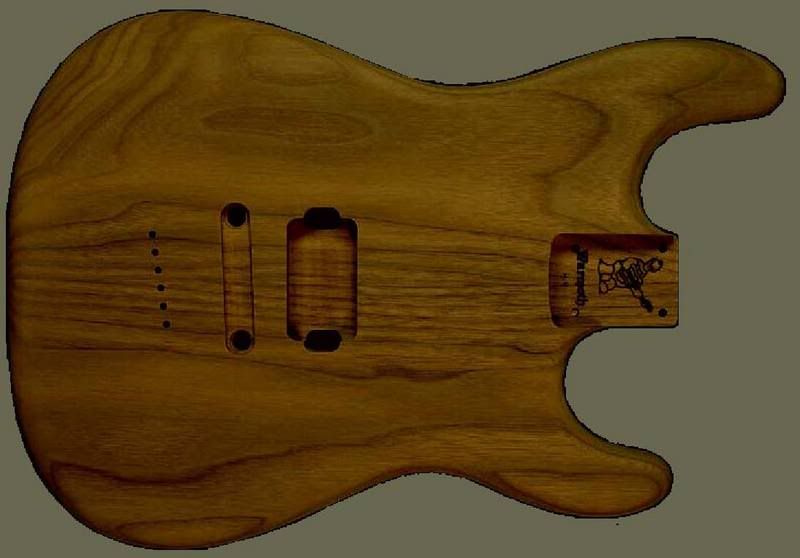 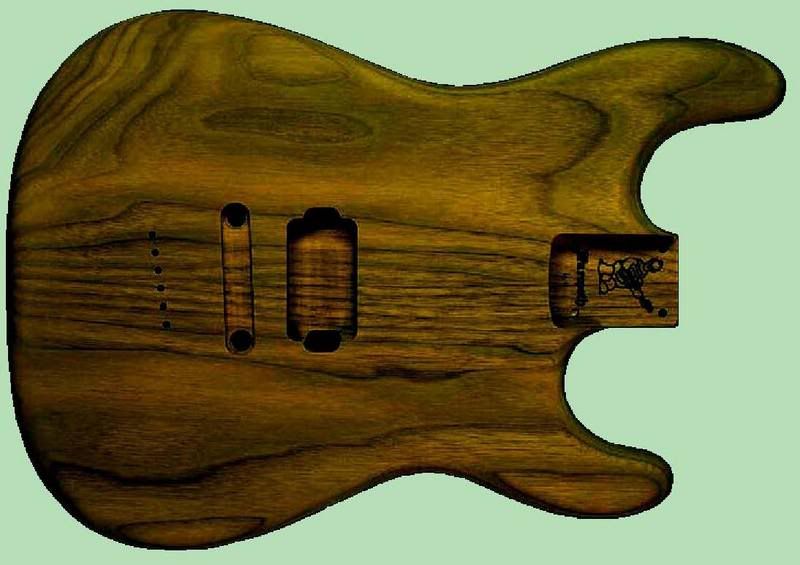 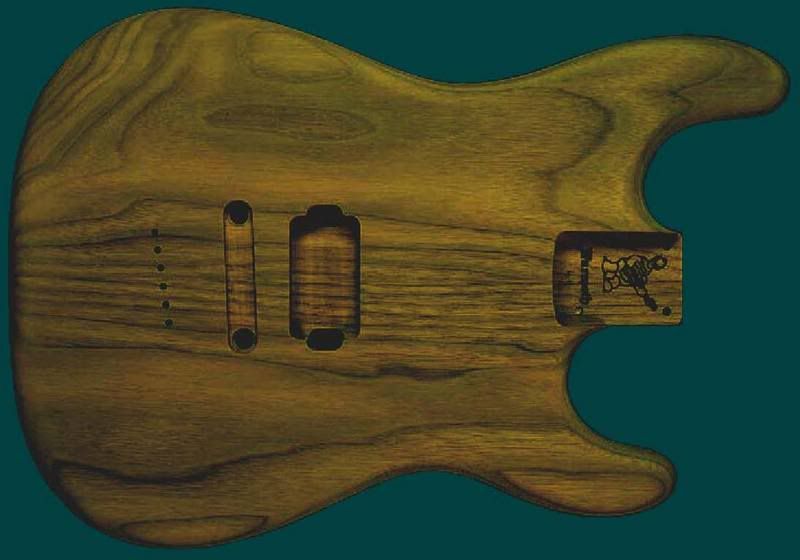 I want it dark to match the neck (wenge/ebony).   Sorry, it was late and I just did a quick cut and paste from the aftermarket site. This route (most similar to what Carvin is doing "new") is a way to alleviate the need for an angled neck pocket with a regular TOM setup. BTW, this one is getting a gold Tone Pros bridge. In fact, gold all around. |
|
|
|
Post by sumgai on Sept 2, 2007 1:52:50 GMT -5
Chris, Skyway MusicUSACG did a few Tele-style guitars routed for this bridge, and put 'em in their Gallery - that was my intro to them. I've been talking to the owner/inventor about building a version equipped with piezo saddles, that was the beta testing I spoke of a few weeks ago. It's gonna be expensive, probably more than the body itself. But this is where the rubber hits the road, which helps to explain my reluctance to part with so many gilders for just the body - that would leave very little of the budget for what I think will be the centerpiece of my masterpiece.  HTH sumgai |
|
|
|
Post by ChrisK on Sept 2, 2007 20:18:58 GMT -5
quote
"I can say that it is totally unique in the world of trems. It holds its tuning better than any trem that I've ever used. The tone is chimey but with the attack and sustain of a hardtail. One of the most unique and cool things is the consistency of that sustain and tonal character during a drop in pitch. with other trems I have always noticed that the sustain and the "boldness" of the note dies off a bit as you dive the bar. With the Skyway, it holds the note strong and the sustain seems uneffected by the greatly lowered pitch.It also has a great degree of control over the micro-movement in pitch. It feels much more "Solid" in its control of the note...like you're attached to the note itself. Whereas with a normal trem it feels like you're controlling something attached to the note..one step removed. It is also easy to get a controlled amp vibrato effect....." /quote
Aaaarrrrggghhhh!
|
|
|
|
Post by sumgai on Sept 2, 2007 20:45:25 GMT -5
Chris, The Pirate's mating call, indeed!  Yes, there is a lot of hyperbole in their soft-sell pitch (aka "testimonials"), but the fact is, the design is entirely new, not just a rehash, like cams, moved pivot points, etc. Basically, it uses a torsion bar (or a pair of 'em, I couldn't get that much out of the guy). Any engineer will recognize that topolgy immediately, and applaud the effort, if not the actual end product. (Engineers being a funny breed. ;D) The downside is that Rick (the inventor) decided to not use off-the-shelf saddles, he designed and built his own. Now he's shopping for a piezo installer who will make saddles for him that can be fitted to hex-pickup designs...... like yours and mine.  When that's done, I'm in line (close to the head of it, if I'm hearing him correctly) to get a set for testing. At my expense, of course, but what's life all about, if you can't dance on the bleeding edge once in awhile, eh?   sumgai |
|
|
|
Post by crazymanandy on Sept 2, 2007 22:41:31 GMT -5
David Myka (of Myka Guitars) has used them....
CMA
|
|